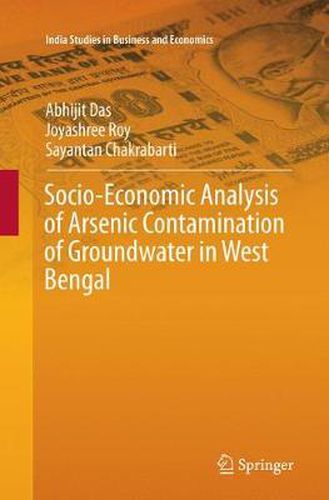Readings Newsletter
Become a Readings Member to make your shopping experience even easier.
Sign in or sign up for free!
You’re not far away from qualifying for FREE standard shipping within Australia
You’ve qualified for FREE standard shipping within Australia
The cart is loading…






This title is printed to order. This book may have been self-published. If so, we cannot guarantee the quality of the content. In the main most books will have gone through the editing process however some may not. We therefore suggest that you be aware of this before ordering this book. If in doubt check either the author or publisher’s details as we are unable to accept any returns unless they are faulty. Please contact us if you have any questions.
This book presents a socio-economic analysis of the issues linking technological innovation in providing arsenic-safe drinking water in rural areas. It presents concrete field based experiences of experiments and case studies depicting the plight and sufferings of people due to failed technological deployment strategies over the past two decades in West Bengal, the most arsenic-exposed state in India and also the first to act for remediation of the crisis. One of the greatest challenges in arsenic-exposed zones is to provide sustainable access to reliably arsenic-safe free water. For nearly twenty years the Government of India and national water distribution institutions in collaboration with multi-lateral funding agencies have sought to pump in money, push technology collected through global tenders, and enlist the support of non-governmental organizations (NGOs), but their efforts have yielded little success. This book is the outcome of the authors’ intensive fieldwork, guided by the conceptual framework of the latest literature on environmental economics and consumer behaviour. It presents a framework and estimates based on field level primary data. Secondary official source-based data are also collated from various scattered sources into a valuable, comprehensive collection. Lastly, the book includes a revealing analysis of factors affecting households’ participation.
$9.00 standard shipping within Australia
FREE standard shipping within Australia for orders over $100.00
Express & International shipping calculated at checkout
This title is printed to order. This book may have been self-published. If so, we cannot guarantee the quality of the content. In the main most books will have gone through the editing process however some may not. We therefore suggest that you be aware of this before ordering this book. If in doubt check either the author or publisher’s details as we are unable to accept any returns unless they are faulty. Please contact us if you have any questions.
This book presents a socio-economic analysis of the issues linking technological innovation in providing arsenic-safe drinking water in rural areas. It presents concrete field based experiences of experiments and case studies depicting the plight and sufferings of people due to failed technological deployment strategies over the past two decades in West Bengal, the most arsenic-exposed state in India and also the first to act for remediation of the crisis. One of the greatest challenges in arsenic-exposed zones is to provide sustainable access to reliably arsenic-safe free water. For nearly twenty years the Government of India and national water distribution institutions in collaboration with multi-lateral funding agencies have sought to pump in money, push technology collected through global tenders, and enlist the support of non-governmental organizations (NGOs), but their efforts have yielded little success. This book is the outcome of the authors’ intensive fieldwork, guided by the conceptual framework of the latest literature on environmental economics and consumer behaviour. It presents a framework and estimates based on field level primary data. Secondary official source-based data are also collated from various scattered sources into a valuable, comprehensive collection. Lastly, the book includes a revealing analysis of factors affecting households’ participation.